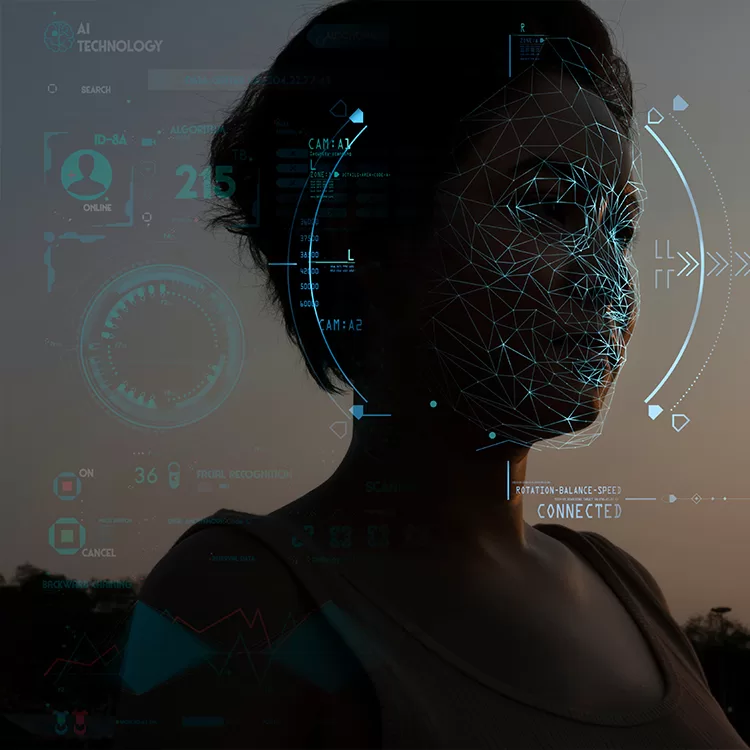Biometrics

Tracking the trainee’s physical reactions while they train allows for proper after training review. Better understanding of how your training is working means constant improvement for your trainees.
Biometrics can be integrated with AI in various ways to enhance security, authentication, and personalised experiences.
By combining biometrics with AI, organisations can enhance security, improve user experiences, and streamline authentication processes. However, it’s important to ensure privacy and data protection while using biometric data and AI technologies.
Some of the ways in which we achieve this is through the use of:

AI algorithms can analyse and authenticate an individual’s identity based on their facial features. Biometric data, such as facial images or video, is captured and processed using AI techniques to verify and match against stored templates.

AI-based algorithms can analyse and match fingerprint patterns to authenticate individuals. Biometric data, such as fingerprint images, is processed using AI techniques to identify unique patterns and compare them with stored templates.

AI can be used to analyse and authenticate an individual’s voice. Biometric data, such as voice recordings, is processed using AI algorithms to identify unique voice characteristics and match them against stored templates.

AI can be used to analyse and authenticate an individual’s voice. Biometric data, such as voice recordings, is processed using AI algorithms to identify unique voice characteristics and match them against stored templates.

AI algorithms can analyse and authenticate an individual’s iris patterns. Biometric data, such as iris images, is processed using AI techniques to identify unique patterns and compare them with stored templates.

AI can analyse and interpret behavioural biometrics, such as typing patterns, gait analysis, or signature recognition. These behavioural traits can be used for authentication or identification purposes.

AI algorithms can analyse and authenticate an individual’s iris patterns. Biometric data, such as iris images, is processed using AI techniques to identify unique patterns and compare them with stored templates.

AI can analyse and interpret behavioural biometrics, such as typing patterns, gait analysis, or signature recognition. These behavioural traits can be used for authentication or identification purposes.
Biometrics can be used in simulated training to enhance the effectiveness and realism of the training experience. By incorporating biometrics into simulated training, we can gain a deeper understanding of trainees’ physiological and cognitive responses, provide real-time feedback and coaching, optimise training scenarios, and track performance improvements. This can lead to more effective and realistic training experiences, better skill acquisition, and enhanced performance in real-world scenarios.
Biometric sensors, such as heart rate monitors or galvanic skin response sensors, can be used to measure trainees’ physiological responses during simulated training scenarios. By monitoring indicators of stress or arousal, trainers can assess trainees’ performance under realistic pressure and provide targeted feedback or interventions to improve performance in high-stress situations.
Biometric data, such as eye-tracking or brainwave monitoring, can help assess trainees’ cognitive load during simulated training. By analysing where trainees focus their attention or measuring brain activity, trainers can understand the mental effort required to complete specific tasks or make decisions. This information can be used to optimize training scenarios or adjust the difficulty level to ensure optimal learning outcomes.
Biometrics can enable real-time feedback and coaching during simulated training. For example, facial expression analysis can provide insights into trainees’ emotional states, allowing trainers to provide immediate feedback on their reactions or decision-making. This can help trainees become aware of their emotional responses and learn how to manage them effectively in challenging situations.
Biometric data can be used to compare trainees’ performance to established benchmarks or expert standards. By collecting and analysing biometric data from multiple trainees, trainers can identify patterns, trends, or outliers, enabling personalized feedback and performance improvement strategies.
Biometric sensors can capture trainees’ physiological responses to environmental stimuli encountered during simulated training, such as temperature, noise, or physical exertion. This data can help trainers optimize training conditions and create more realistic simulations, ensuring trainees are exposed to relevant stressors and challenges.
Biometric data collected during simulated training can be analysed post-training to evaluate trainees’ performance, identify areas for improvement, and track skill development over time. This analysis can provide valuable insights into trainees’ physiological and cognitive responses, helping trainers refine training programs and tailor individualised coaching plans

3.05, Innovation and Collaboration Hub,
Portsdown Technology Park, North Hill, Portsmouth, PO6 3RU
Tel: +44 (0) 2393 552794
Email: info@m-works.co.uk





Copyright © 2024 MWorks | Privacy Policy